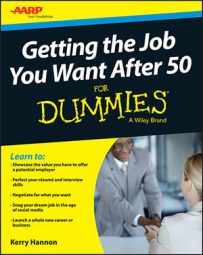Copyright © 2015 AARP. All rights reserved.
Interviews come in all flavors. If you want to show that you are up with the times after the age of 50, make sure you are able to adapt to any interview format. To improve your performance on a telephone interview, follow these suggestions:
Use a landline phone, if possible. Avoid spotty cellphone and VoIP (Voice over Internet Protocol) connections. A landline removes the technical difficulties that may unnerve you during the interview.
Pick a quiet location. Find a comfortable place without distractions from people, pets, music, and street noise. Inform everyone in the household that you’re going to be on a very important phone call and are not to be disturbed.
Turn off other phones and mute the speakers on your computer. You don’t want anything ringing or dinging in the background.
Lay out a copy of your résumé and the job description. You may need to refer to details from these documents during the call, but don’t read off of them, because reading can sound stiff.
Have paper and pen handy. Jot down notes during the conversation, if that helps you follow the conversation and keep track of what’s been said. However, if note-taking interferes with your ability to listen and respond, then keep your note-taking to a minimum. You should still have paper and pen handy, just in case.
Have a drink nearby. A glass of water is best or a cup of coffee or tea if you’re looking for a little caffeine bump. Keeping your whistle wet helps you steer clear of throat clearing, which is awkward and ruins the flow of conversation. And if you haven’t said anything in a while, warm up your voice before the phone rings.
Smile. Interviewers can hear a smile over the phone. You’ll sound upbeat and convey a sense that you’re happy to have the opportunity to discuss the opening. Smile especially when you answer the phone and greet the caller, when you talk about your work and what you’re passionate about, and when you ask questions about the company.
Put a mirror in front of yourself, so you can make sure you’re smiling.
Pay attention to your posture. Stand or sit up straight, during the call. It makes your voice sound stronger and more energetic.
Be ready to go ten minutes ahead of time. You don’t want to sound hurried.
Answer professionally. When the phone rings, smile, and greet the caller with something like, “Hi, this is [name].” If you know who’s calling (from Caller ID), consider following up with “Is this [name]?” Don’t try to pretend that you don’t know who’s calling, because that can make you sound phony.
Listen carefully before you speak. Pause before you answer to gather your thoughts. Then talk. Try to answer each question in two minutes or less. Otherwise, your interviewer may tune out. Because you can’t see the person, it’s tempting to fill in any pauses in the conversation, but rein it in.
Enunciate your words and don’t speak too fast. Projecting your voice distinctly and enthusiastically is fundamental.
Avoid fillers such as “like,” “you know,” and “um.” Use precise language to communicate your thoughts. Remind yourself that short pauses are acceptable and much preferred over fillers that can make you sound less sophisticated.
End on an up note. If you really want the job, finish your conversation by saying, “Thanks for the call. I’m very interested in what we’ve discussed today and would appreciate the opportunity to meet you in person. What’s the next step?” Think of this as your call to action.

